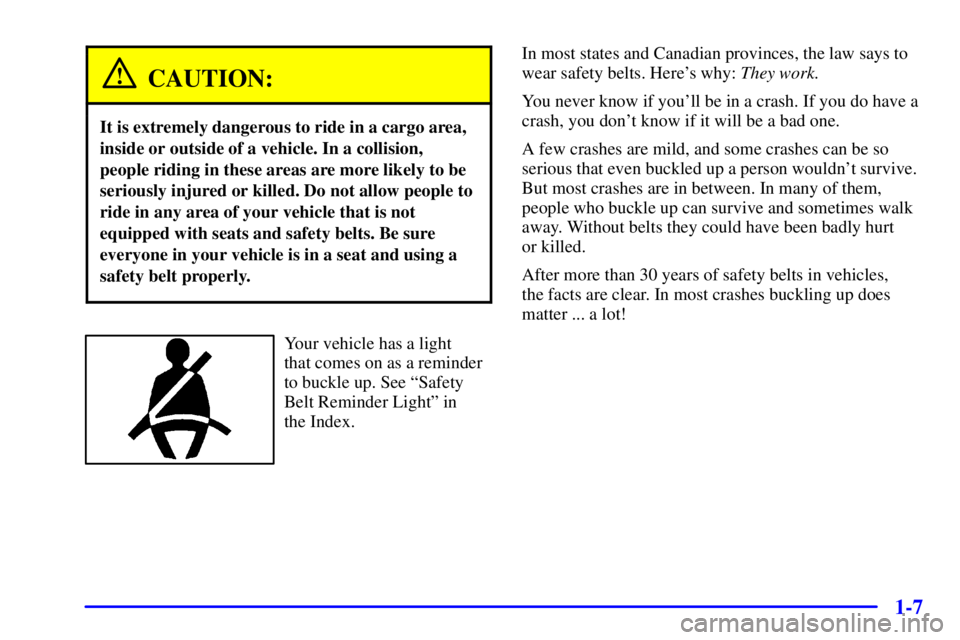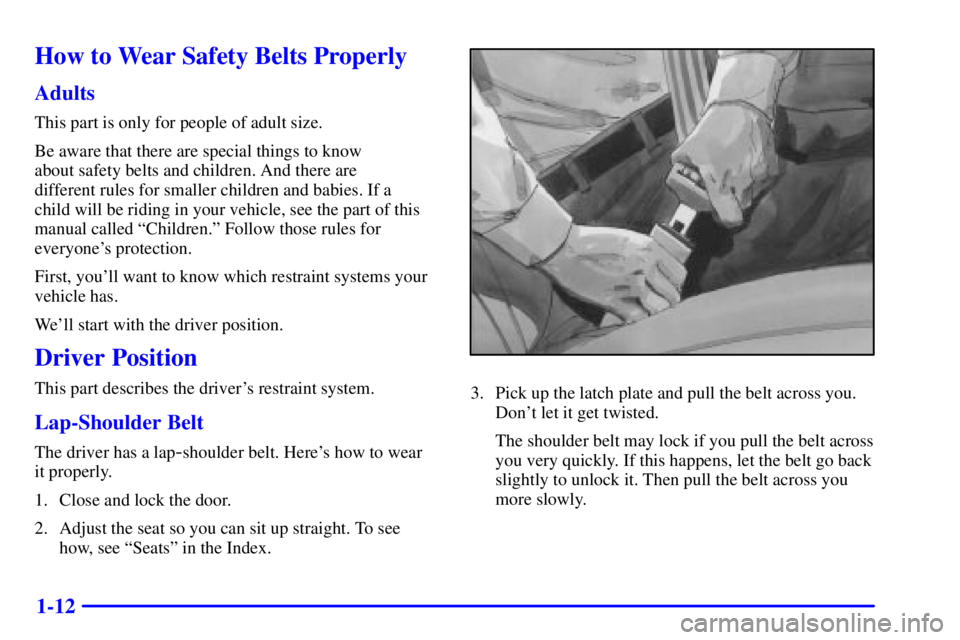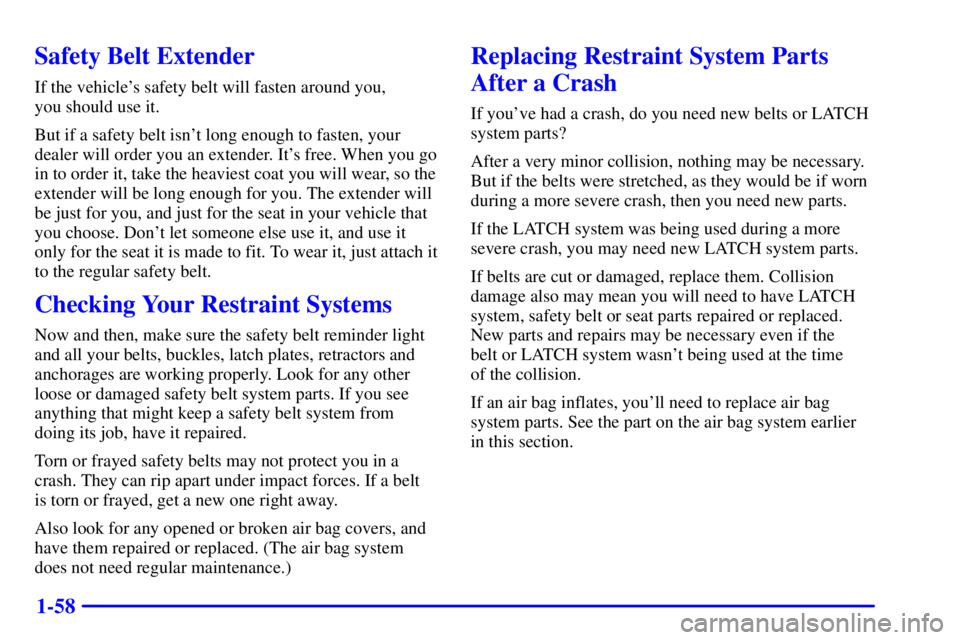Page 5 of 368

iv
Vehicle Damage Warnings
Also, in this book you will find these notices:
NOTICE:
These mean there is something that could damage
your vehicle.
In the notice area, we tell you about something that
can damage your vehicle. Many times, this damage
would not be covered by your warranty, and it could
be costly. But the notice will tell you what to do to help
avoid the damage.
When you read other manuals, you might see
CAUTION and NOTICE warnings in different
colors or in different words.
You'll also see warning labels on your vehicle.
They use the same words, CAUTION or NOTICE.
Vehicle Symbols
Your vehicle may be equipped with components and
labels that use symbols instead of text. Symbols,
used on your vehicle, are shown along with the text
describing the operation or information relating to a
specific component, control, message, gage or indicator.
If you need help figuring out a specific name of a
component, gage or indicator reference the following
topics in the Index:
�ªEngine Compartment Overviewº
�ªInstrument Panelº
�ªComfort Controlsº
�ªAudio Systemsº
Also see ªWarning Lights and Gagesº in the Index.
Page 13 of 368

1-7
CAUTION:
It is extremely dangerous to ride in a cargo area,
inside or outside of a vehicle. In a collision,
people riding in these areas are more likely to be
seriously injured or killed. Do not allow people to
ride in any area of your vehicle that is not
equipped with seats and safety belts. Be sure
everyone in your vehicle is in a seat and using a
safety belt properly.
Your vehicle has a light
that comes on as a reminder
to buckle up. See ªSafety
Belt Reminder Lightº in
the Index.In most states and Canadian provinces, the law says to
wear safety belts. Here's why: They work.
You never know if you'll be in a crash. If you do have a
crash, you don't know if it will be a bad one.
A few crashes are mild, and some crashes can be so
serious that even buckled up a person wouldn't survive.
But most crashes are in between. In many of them,
people who buckle up can survive and sometimes walk
away. Without belts they could have been badly hurt
or killed.
After more than 30 years of safety belts in vehicles,
the facts are clear. In most crashes buckling up does
matter ... a lot!
Page 18 of 368

1-12
How to Wear Safety Belts Properly
Adults
This part is only for people of adult size.
Be aware that there are special things to know
about safety belts and children. And there are
different rules for smaller children and babies. If a
child will be riding in your vehicle, see the part of this
manual called ªChildren.º Follow those rules for
everyone's protection.
First, you'll want to know which restraint systems your
vehicle has.
We'll start with the driver position.
Driver Position
This part describes the driver's restraint system.
Lap-Shoulder Belt
The driver has a lap-shoulder belt. Here's how to wear
it properly.
1. Close and lock the door.
2. Adjust the seat so you can sit up straight. To see
how, see ªSeatsº in the Index.
3. Pick up the latch plate and pull the belt across you.
Don't let it get twisted.
The shoulder belt may lock if you pull the belt across
you very quickly. If this happens, let the belt go back
slightly to unlock it. Then pull the belt across you
more slowly.
Page 29 of 368
1-23
There is an air bag
readiness light on the
instrument panel,
which shows the air
bag symbol.
The system checks the air bag electrical system for
malfunctions. The light tells you if there is an electrical
problem. See ªAir Bag Readiness Lightº in the Index
for more information.How the Air Bag Systems Work
Where are the air bags?
The driver's frontal air bag is in the middle of the
steering wheel.
Page 35 of 368
1-29
1. Pick up the latch plate and pull the belt across you.
Don't let it get twisted.
The shoulder belt may lock if you pull the belt across
you very quickly. If this happens, let the belt go back
slightly to unlock it. Then pull the belt across you
more slowly.
2. Push the latch plate into the buckle until it clicks.
Pull up on the latch plate to make sure it is secure.When the shoulder belt is pulled out all the way, it
will lock. If it does, let it go back all the way and
start again. If the belt is not long enough, see ªSafety
Belt Extenderº at the end of this section. Make sure
the release button on the buckle is positioned so you
would be able to unbuckle the safety belt quickly if
you ever had to.
3. To make the lap part tight, pull down on the buckle
end of the belt as you pull up on the shoulder part.
Page 64 of 368

1-58
Safety Belt Extender
If the vehicle's safety belt will fasten around you,
you should use it.
But if a safety belt isn't long enough to fasten, your
dealer will order you an extender. It's free. When you go
in to order it, take the heaviest coat you will wear, so the
extender will be long enough for you. The extender will
be just for you, and just for the seat in your vehicle that
you choose. Don't let someone else use it, and use it
only for the seat it is made to fit. To wear it, just attach it
to the regular safety belt.
Checking Your Restraint Systems
Now and then, make sure the safety belt reminder light
and all your belts, buckles, latch plates, retractors and
anchorages are working properly. Look for any other
loose or damaged safety belt system parts. If you see
anything that might keep a safety belt system from
doing its job, have it repaired.
Torn or frayed safety belts may not protect you in a
crash. They can rip apart under impact forces. If a belt
is torn or frayed, get a new one right away.
Also look for any opened or broken air bag covers, and
have them repaired or replaced. (The air bag system
does not need regular maintenance.)
Replacing Restraint System Parts
After a Crash
If you've had a crash, do you need new belts or LATCH
system parts?
After a very minor collision, nothing may be necessary.
But if the belts were stretched, as they would be if worn
during a more severe crash, then you need new parts.
If the LATCH system was being used during a more
severe crash, you may need new LATCH system parts.
If belts are cut or damaged, replace them. Collision
damage also may mean you will need to have LATCH
system, safety belt or seat parts repaired or replaced.
New parts and repairs may be necessary even if the
belt or LATCH system wasn't being used at the time
of the collision.
If an air bag inflates, you'll need to replace air bag
system parts. See the part on the air bag system earlier
in this section.
Page 65 of 368

2-
2-1
Section 2 Features and Controls
Here you can learn about the many standard and optional features on your vehicle, and information on starting,
shifting and braking. Also explained are the instrument panel and the warning systems that tell you if everything is
working properly
-- and what to do if you have a problem.
2
-2 Windows
2
-4 Keys
2
-6 Door Locks
2
-10 Remote Keyless Entry
2
-17 Trunk
2
-22 Theft
2
-23 PASS-Key� II
2
-24 New Vehicle ªBreak-Inº
2
-25 Ignition Positions
2
-26 Starting Your Engine
2
-27 Engine Coolant Heater (If Equipped)
2
-28 Automatic Transaxle Operation
2
-33 Parking Brake
2
-34 Shifting Into PARK (P)
2
-36 Shifting Out of PARK (P)
2
-37 Parking Over Things That Burn
2
-38 Engine Exhaust
2
-38 Running Your Engine While You're Parked2
-39 Horn
2
-39 Tilt Wheel
2
-40 Turn Signal/Multifunction Lever
2
-46 Exterior Lamps
2
-49 Interior Lamps
2
-52 Mirrors
2
-56 Storage Compartments
2
-58 Sun Visors
2
-58 Auxiliary Power Outlet
2
-59 Auxiliary Power Connection (Power Drop)
2
-60 OnStar�System (If Equipped)
2
-64 Sunroof (Option)
2
-65 The Instrument Panel -- Your
Information System
2
-66 Instrument Panel Cluster
2
-68 Warning Lights, Gages and Indicators
2
-82 Driver Information Center (Option)
Page 75 of 368

2-11 Operation
Press UNLOCK once to
unlock the driver's door and
to turn on the interior lamps
(see ªIllumination on
Remote Activationº in the
Index for more details).
The perimeter lighting feature will also be activated at
night, turning on your headlamps and back
-up lamps for
approximately 25 seconds when the UNLOCK button is
pressed. (This will light the area around the vehicle.)
See ªPerimeter Lightingº in the Index.
Press UNLOCK again within five seconds to unlock all
the doors. To lock all doors, press LOCK. To unlock the
trunk, press the button with the trunk symbol on the
remote keyless entry transmitter. The trunk will only
unlock if your transaxle is in PARK (P).Panic Alarm
This feature allows you to activate an alarm by pressing a
button on the remote keyless entry transmitter. Your
ignition must be off for the panic alarm to work. When
you press the panic button with the horn symbol on it the
remote keyless entry transmitter, the headlamps will
flash, the horn will honk repeatedly, and the interior
lamps will illuminate, attracting attention if you need it.
The alarm will continue until one of the following occurs:
�You press the panic button on the remote keyless
entry transmitter a second time,
�the ignition moved to RUN, or
�an alarm period of about two minutes has elapsed.
Security Feedback
Security feedback provides audible and/or visible
feedback confirming that a remote keyless entry lock
or unlock command has been received and executed.
The ignition must be off for this feature to work.
You may select one of four operating modes for reception
of a lock command. You may also select one of four
operating modes for reception of an unlock command.
The selection and programming of the lock and unlock
operating modes are independent of each other.